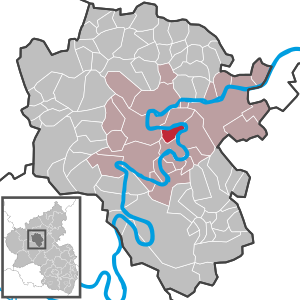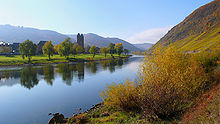Ernst (Moselle)
| coat of arms | Germany map | |
|---|---|---|

|
Coordinates: 50 ° 9 ′ N , 7 ° 14 ′ E |
|
| Basic data | ||
| State : | Rhineland-Palatinate | |
| County : | Cochem cell | |
| Association municipality : | Cochem | |
| Height : | 90 m above sea level NHN | |
| Area : | 4.18 km 2 | |
| Residents: | 545 (Dec. 31, 2019) | |
| Population density : | 130 inhabitants per km 2 | |
| Postal code : | 56814 | |
| Area code : | 02671 | |
| License plate : | COC, ZEL | |
| Community key : | 07 1 35 027 | |
| Association administration address: | Ravenéstrasse 61 56812 Cochem |
|
| Website : | ||
| Local Mayor : | Bernd Schüller | |
| Location of the local community Ernst in the district of Cochem-Zell | ||
Ernst is a wine village on the Moselle . The local community belongs to the Rhineland-Palatinate district of Cochem-Zell and belongs to the Cochem community . Valwig is on the opposite side of the Moselle .
history
Ernst 777/778 is mentioned for the first time as "Arnesche". Today's community of Ernst consists of two previously independent town centers: Oberernst with parish church and old town hall and Niederernst, which grew from the 18th century onwards. The Archbishopric of Trier was the sovereign until it was occupied by the French Revolutionary Army in 1794. In 1815, at the Congress of Vienna , the two places were assigned to the Kingdom of Prussia and a little later the two places were combined into one municipality. Since 1946 the place has been part of the then newly formed state of Rhineland-Palatinate .
Municipal council
The municipal council in Ernst consists of twelve council members, who were elected by a majority vote in the local elections on May 26, 2019 , and the honorary local mayor as chairman.
Parish Church of St. Salvator
From the outside, the image of a cross-domed church with a double tower facade emerges. Made entirely of unplastered quarry stone masonry with built-in decorative elements made of red and white sandstone, the building results in an unexpected, lively, colorful overall picture. All windows are made of red sandstone cladding. The cornice stones in white sandstone are overall very nicely structured. The double tower facade on the street side is particularly striking. Above a portal covered in red sandstone profile is a large round window with richly profiled red sandstone garments to illuminate the organ gallery.
Ornamental surfaces, which are alternately made of quarry stone and red stone, frame this, as do all of the round-arched parts of the church windows. The frame of the gable to the verge is completed in steps. The gussets are filled with triangular tuff stones.
The interior of the church presents itself as a square, three-aisled and three-bay hall church. In the area of the middle bay, the church space expands like a transept. Four round columns are set in the square nave so that a large yoke is flanked in the middle by smaller rectangular ones and small square yokes are separated in the corners. The arches typical of Lassaulx sit vertically above the square cover plates of the capitals. The edges of the straps that separate the transept-like extension, the choir and the yoke between the towers from the ship are underlaid with stucco beads.
To the south, the central nave opens up to the choir, which is built over a three-quarter round floor plan. This choir design was realized for the first time in the Weißenturmer Trinitatis Church in Lassaulx. The direct model for this solution is the chapel on the Oberburg in Kobern. Immediately before the Weißenturm commission in 1835, it was restored by Lassaulx and he is so fascinated by this choir design that he publishes it and uses it in all other church buildings. Apart from Ernst, this concept can be found in Nickenich and Boppard.
The choir is raised by 5 steps and covered with a six-part ridge vault. The resulting arches stand out as a semicircle on the round choir wall. In the outer glare fields of the shield arches, two arched windows illuminate the altar very effectively.
The two side altars are from the old parish church. They are sandstone altars that could have come from the Hoffmann School. Both were created in 1610 and 1620 and come from the old parish church.
On July 25, 1853, Bishop Arnoldi consecrated the church in the presence of 21 clergy from the area. To the east of the church, in the direction of Oberernst, the cemetery was laid out in 1856.
For Ernst it was a stroke of luck that Johann Claudius von Lassaulx was won over as architect. As a church builder, he had made a name for himself far beyond the Rhineland. His personal inclination to the historical and especially to the arched style gave us the beautiful church, which today is regarded as the culmination of his work.
Experts regard the Ernster Church as the sum of all the experience as a church builder and monument conservator that Claudius von Lassaulx was able to acquire in his more than 25 years of sacred building activity.
The double-towered parish church of St. Salvator, built in 1845 in neo-Romanesque style from Rhenish slate, is Ernst's landmark.
See also: List of cultural monuments in Ernst
Born in earnest
- Peter Homphaeus II (around 1470–1537), priest, scientist and teacher
Others
In 2005, Ernst won the competition Our village has a future .
Web links
- Internet presence of the local community Ernst
- Literature about Ernst in the Rhineland-Palatinate State Bibliography
- General Directorate for Cultural Heritage Rhineland-Palatinate (Ed.): Informational directory of cultural monuments - Cochem-Zell district. Mainz 2020, p. 20 ff. (PDF; 4.6 MB).
Individual evidence
- ↑ State Statistical Office of Rhineland-Palatinate - population status 2019, districts, communities, association communities ( help on this ).
- ^ The Regional Returning Officer Rhineland-Palatinate: Local elections 2019, city and municipal council elections





